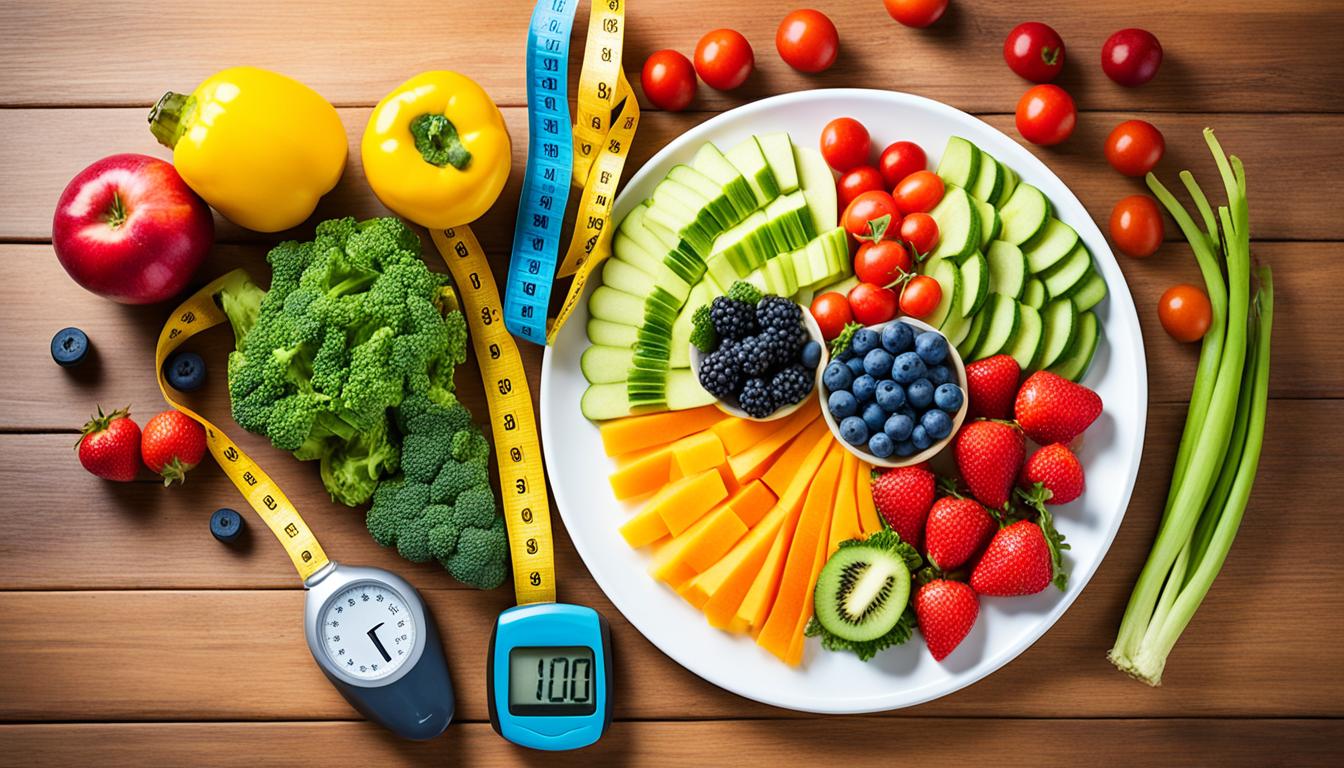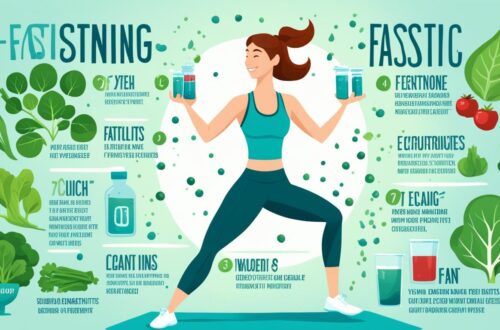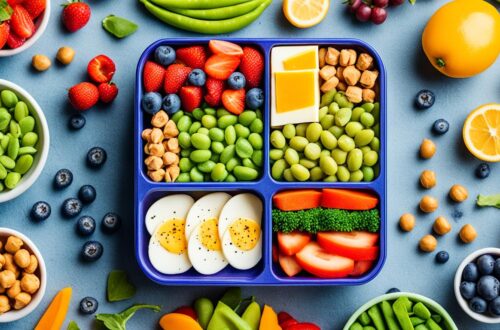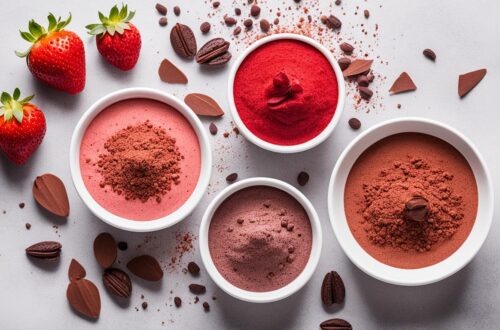Did you know that more than 1 in 3 American adults have pre-diabetes? Yet, 84% of them don’t know about it. This shows we need to act fast to manage pre-diabetes and avoid type 2 diabetes. Good news is, eating clean helps keep blood sugar healthy and improves your well-being.
This guide shows you how to manage pre-diabetes by eating right. You’ll learn about insulin and glucose. Plus, you’ll see why eating foods packed with nutrients and low on the glycemic index is crucial. This knowledge will help you take charge of your health and lower the risk of getting type 2 diabetes.
Key Takeaways
- Pre-diabetes impacts over 88 million U.S. adults, yet most are unaware.
- Managing pre-diabetic blood sugar well cuts your type 2 diabetes risk.
- Eating whole, low-glycemic, nutrient-rich foods stabilizes blood sugar and boosts health.
- Planning meals, controlling portions, and eating anti-inflammatory foods are key for managing blood sugar.
- Regular exercise also improves how your body handles blood sugar.
Understanding Pre-Diabetes and Blood Sugar Regulation
Pre-diabetes is a serious health issue that needs our focus. It comes before type 2 diabetes. Millions suffer from type 2 diabetes. Knowing how insulin and glucose work in our bodies is key. It helps us control blood sugar in pre-diabetes and avoid worse health problems.
What is Pre-Diabetes?
In pre-diabetes, blood sugar is high but not yet at type 2 diabetes levels. This happens when the body doesn’t use insulin well, called insulin resistance. Insulin is important for handling blood sugar. Pre-diabetes can turn into type 2 diabetes, raising the risk of heart disease and other issues.
The Role of Insulin and Glucose
Insulin plays a key role in keeping blood sugar in check. When you eat carbs, your body changes them into glucose. Insulin then lets this glucose into your cells. There, it’s used for energy or stored away. In pre-diabetes, your cells not reacting well to insulin causes too much glucose in your blood. This leads to high blood sugar levels.
- Insulin allows cells to use or store glucose, keeping blood sugar stable.
- In pre-diabetes, insulin doesn’t work as it should, leading to high blood sugar.
- This can turn into type 2 diabetes, which has big health risks.
Understanding these processes can help you manage and control pre-diabetes. This lowers the risk of getting type 2 diabetes.
“Addressing pre-diabetes is crucial for maintaining overall health and preventing the onset of more serious conditions.”
The Benefits of Clean Eating for Pre-Diabetic Blood Sugar Management
If you’re facing pre-diabetes, clean eating can be a big help. It focuses on whole foods that are not heavily processed. These foods are low in bad sugars, fats, and carbs. Switching to this diet can bring you a lot of good, like keeping your blood sugar steady. It also lowers your risk of getting type 2 diabetes.
Clean eating is great for those dealing with pre-diabetes. It makes your body better at using insulin. This means your blood sugar is more stable. It also eases the work your pancreas has to do. This way, the risk of having problems with insulin goes down.
Eating clean means you get to enjoy anti-inflammatory foods. These foods are awesome because they fight inflammation. Processed and sugary foods can kick-start inflammation. This can lead to issues like insulin resistance. But when you eat whole grains, lean proteins, plus lots of fruits and veggies, you are fighting back. Your metabolism will thank you.
Clean eating also helps with maintaining a healthy weight. Being overweight can make pre-diabetes turn into type 2. Good, low-calorie foods help you stay healthy. And you don’t have to diet hard or do anything extreme.
Choosing to eat clean teaches you a lot about nutrition. You’ll learn about carbs, proteins, the impacts of different foods. This knowledge is power. It lets you take control of your health and your blood sugar.
CLICK HERE FOR SOME MEAL PREPPING IDEAS
MEAL PREP CONTAINERS COME IN HANDY.
Low-Glycemic and Nutrient-Dense Foods for Stable Blood Sugar

Staying on top of your blood sugar is key if you have pre-diabetes. Eating foods that are low-glycemic and packed with nutrients is a smart move. You should add whole grains, complex carbs, lean proteins, and plant-based proteins to your meals. These foods can help keep your blood sugar in check.
Whole Grains and Complex Carbohydrates
Brown rice, quinoa, and whole wheat are great for those with pre-diabetes. These are complex carbs. They are digested slowly, avoiding quick blood sugar spikes and keeping you full longer. Always go for whole foods instead of processed ones. This way, you get the best nutrition.
- Incorporate whole grain breads, cereals, and pasta into your meals.
- Try complex carbohydrates like sweet potatoes, oats, and barley.
- Avoid refined or white flour products, which can cause rapid blood sugar increases.
Lean Proteins and Plant-Based Proteins
Eating lean and plant-based proteins is also good for keeping your blood sugar level. Choices like poultry, fish, and legumes are better than sugary foods. They take longer to digest and avoid blood sugar spikes. Lentils, tofu, and nuts are great options for protein if you have pre-diabetes.
- Choose lean cuts of meat, poultry, and fish to keep your protein sources low in fat.
- Incorporate plant-based proteins like beans, lentils, and nuts into your meals.
- Avoid processed meats, which can be high in sodium and preservatives.
Focusing on low-glycemic and nutrient-rich foods is a big step in managing your pre-diabetes. A balanced diet filled with such foods helps a lot. It keeps your blood sugar steady and promotes good health.
pre-diabetic blood sugar management clean food what to eat healthy
Managing pre-diabetic blood sugar levels by eating clean is key. This choice helps stop diabetes from developing. It’s all about choosing low-glycemic, nutrient-packed whole foods. These foods help control your blood sugar and keep you healthy. Let’s look at the top clean eating choices for your pre-diabetes diet plan.
Whole Grains and Complex Carbohydrates
Go for whole grains like brown rice, quinoa, oats, and whole wheat. These carbs are full of fiber. This fiber slows down how fast your body absorbs glucose. That means your blood sugar stays even. Plus, these foods bring you important vitamins and minerals for your health.
Lean Proteins and Plant-Based Proteins
Add lean proteins to your meals, such as chicken, turkey, fish, and legumes. These foods help keep your blood sugar steady. They also make you feel full. Include plant-based proteins, like tofu, tempeh, or lentils. They’re low in carbs and rich in fiber, which is great for you.
Fruits and Vegetables
Eat lots of fresh, colorful fruits and veggies. They are low on the glycemic index, so they don’t spike your blood sugar fast. Include leafy greens, berries, and citrus fruits. They’re full of important nutrients and antioxidants.
Healthy Fats
Don’t forget about healthy fats from avocado, nuts, seeds, and olive oil. These fats taste good and help control the absorption of carbs. This also keeps your blood sugar from spiking.
Choosing these clean, whole foods can help you handle your pre-diabetic blood sugar levels. It supports your overall health too. Always remember to watch how much you eat and keep a balanced plate. This leads to a diet plan that’s good for your health.
CLICK HERE TO CHECK OUT SOME MEAL-PLANNING COOKBOOKS AND GUIDES.
“Eating clean, whole foods is one of the best ways to deal with pre-diabetic blood sugar levels. It also lowers your chance of getting type 2 diabetes.”
Meal Planning and Portion Control for Pre-Diabetes

Pre-diabetes can be managed well by watching what you eat. It’s important to create a plate that’s balanced and watch how much you eat. This helps keep your blood sugar in check and improves your health. We’ll show you how to plan your meals and control portions, putting you in charge of your condition.
Creating a Balanced Plate
For those with pre-diabetes, eating right is key. A mix of foods high in nutrients can keep your blood sugar steady. Use this formula for a balanced plate:
- Put non-starchy vegetables, like leafy greens, broccoli, or bell peppers, on half your plate.
- Choose a lean protein for a quarter of your plate, such as grilled chicken, baked fish, or plant-based options.
- Use the last quarter for complex carbs, like whole grains, quinoa, or a small amount of starchy veggies.
Portion Sizes and Frequency
Keeping an eye on your meal sizes is crucial if you have pre-diabetes. It’s wise to know how much to eat and when to eat. Here’s what to keep in mind:
- Eat smaller but more meals. This keeps your blood sugar steady by eating every 3-4 hours.
- At meal times, a good goal is 4-6 ounces of protein, 1/2 cup of complex carbs, and 1 cup of veggies.
- Snack smartly, picking foods low in added sugars and rich in fiber, protein, or healthy fats. Options include fruits, nuts, or Greek yogurt.
CLICK HERE FOR SOME CUTE AND QUALITY PORCELAIN PORTION CONTROL PLATES!
These tactics are key for managing pre-diabetes. By following these strategies daily, you can make a real difference in your health.
Incorporating Anti-Inflammatory Foods

Stable blood sugar is key for people dealing with pre-diabetes. Adding anti-inflammatory foods to your meals can work wonders. These foods not only fight inflammation but also ease insulin resistance and other pre-diabetes issues.
Inflammation and insulin resistance often go hand in hand. Choosing foods that fight inflammation can help make your blood sugar stay healthier. Now, let’s look at some top foods that reduce inflammation for those with pre-diabetes.
Omega-3 Rich Foods
Such as salmon and sardines, fatty fish are loaded with omega-3. Eating these fish a few times a week can lower inflammation. This also helps with how your body responds to insulin.
Leafy Greens and Cruciferous Vegetables
Kale, spinach, and more are full of antioxidants and vitamins. They fight inflammation too. These types of foods should always be in your eating plan if you have pre-diabetes.
Turmeric and Ginger
Turmeric and ginger are spices known for their anti-inflammatory benefits. Use them in cooking or take them as supplements. This can help you with managing your blood sugar.
Berries and Citrus Fruits
Berries like blueberries and fruits like oranges are packed with antioxidants. They help lower inflammation. Their benefits are great for your overall health too.
Making these foods a part of your pre-diabetic diet is a smart move. Starting with a few dietary changes can help you handle insulin better. Also, remember that good nutrition, exercise, and lifestyle changes are all part of managing pre-diabetes well. It’s the combination of these that really makes a difference. This approach can help avoid type 2 diabetes too.
TO START HEALING YOUR IMMUNE SYSTEM, CHECK OUT THIS BEST-SELLING ANTI-INFLAMMATORY DIET FOR BEGINNERS!
Managing Glucose Spikes and Cravings
Pre-diabetes needs careful handling to control glucose spikes and cravings. Roots of these issues lie in what we eat and some lifestyle choices. Knowing what causes these changes is crucial for managing your blood sugar.
CONSIDER GETTING AN AT-HOME BLOOD SUGAR MONITOR KIT BY CLICKING HERE!
Identifying Triggers
Glucose spikes and cravings often point back to your diet and daily routine. Some common triggers are:
- Consuming too many refined carbs like white bread, pasta, or sweet snacks
- Skipping meals or waiting too long to eat again
- Getting stressed, which affects your body’s hormones
- Not getting enough sleep or having poor sleep quality
By keeping a close eye on your body’s reactions to different foods and activities, you’ll spot the triggers unique to you. This helps in making the right changes to keep your blood sugar level safe.
Healthy Snack Options
Having a plan for when cravings hit is essential. Go for snacks that are good for you but won’t hike up glucose levels. Here’s a list of healthy snack ideas:
- Fresh vegetables with hummus or nut butter
- Greek yogurt topped with berries and a pinch of cinnamon
- Mixed nuts or seeds
- A sliced apple with a bit of cheese
- Celery sticks with cream cheese or tahini
These snacks give you a good mix of complex carbs, fiber, and protein. They help keep your blood sugar steady and keep you full until the next meal.
Know your triggers and keep healthy snacks ready. This approach helps a lot in handling glucose spikes and cravings. It supports your efforts in managing pre-diabetes.
Exercise and Lifestyle Habits for Better Blood Sugar Control

To manage pre-diabetic blood sugar well, eating right isn’t enough. It’s vital to also exercise and live healthily. These help your body use insulin better and control blood glucose levels. We’ll look at steps to help you handle pre-diabetes well and lower the chance of getting type 2 diabetes.
The Power of Physical Activity
Exercise is key in preventing diabetes and managing insulin resistance. It uses up the sugar in your blood for energy. This makes your body better at handling blood glucose and responding to insulin.
- Strive for 30 minutes of activities like fast walking, biking, or swimming most days.
- Do strength training a few times a week. This boosts your muscle and insulin’s effectiveness.
- Try high-intensity workouts to further enhance your metabolism and blood sugar control.
A GREAT BEGINNER STRENGTH TRAINING SET IS NOW ON SALE HERE!
Lifestyle Habits for Optimal Health
Aside from exercise, good living plays a big part in managing pre-diabetic blood sugar. Healthy habits lower stress, aid sleep, and support well-being. These are crucial for keeping your blood glucose levels stable.
- Stress Management: Practice activities like meditation or yoga to reduce stress and stabilize blood sugar.
- Adequate Sleep: Get 7-9 hours of sleep nightly. Not enough sleep can mess with your hormones and lead to insulin resistance.
- Hydration: Drink lots of water daily to help control your blood glucose and stay healthy.
By exercising often and living right, you can impact your pre-diabetic blood sugar levels. This can lower your type 2 diabetes risk. Committing to your well-being makes a big difference in keeping your blood glucose in check.
“The key to successful pre-diabetic blood sugar management lies in the integration of a clean eating plan and an active, balanced lifestyle.”
Conclusion
By choosing clean eating, adding healthy, low-glycemic foods, and changing your lifestyle, you can manage pre-diabetes. This guide gives you the tools to fight pre-diabetes and stop it from getting worse.
A diet with lots of whole grains, lean proteins, and plants can steady your blood sugar. Exercise and managing stress help too. These steps lead to better health and cut your diabetes risk.
Keep up with your healthy eating and life changes. Talk to your doctor for advice and checks. With the right plan, you can keep pre-diabetes in check and live fully.
FAQ
What is pre-diabetes and how does it differ from type 2 diabetes?
Pre-diabetes is when your blood sugar is higher than normal but not as high as in type 2 diabetes. It’s a warning that your body isn’t handling sugar well.
How do insulin and glucose play a role in blood sugar regulation?
Insulin, made in the pancreas, helps cells use glucose for energy. But with pre-diabetes, the body might not respond well to insulin, leading to high blood sugar.
What are the benefits of a clean eating approach for managing pre-diabetic blood sugar levels?
Eating whole, minimally processed foods can help stabilize blood sugar. It can also lessen inflammation and boost your overall health.
Check out: Diabetes Cookbook and Meal Plan and The Science-Backed Anti-Inflammatory Diet for Beginners Cookbook!
What are some examples of low-glycemic and nutrient-dense foods that can help with blood sugar management?
Low-glycemic, nutrient-dense foods are key for managing blood sugar. Think of quinoa, brown rice, chicken, and fish. Lentils and beans are also great, alongside fruits and veggies with a low glycemic index.
How can I incorporate anti-inflammatory foods into my pre-diabetic diet?
Eat leafy greens, berries, fish, and nuts to cut down on inflammation. This can make your body more responsive to insulin and help manage your blood sugar.
How can I manage glucose spikes and cravings as a pre-diabetic individual?
Understand what makes your blood sugar spike or gives you cravings, like stress or certain foods. Try healthy snacks like Greek yogurt with berries or nuts to keep your blood sugar steady.
What role does exercise and lifestyle habits play in better blood sugar control for pre-diabetes?
Moving more, handling stress, and sleeping well are huge for blood sugar control. These lifestyle changes can improve how your body uses insulin and your overall health.




